Texas is home to different species of snakes. It’s inevitable to see one, even if you’re walking on the road or in the park. By now, you’re probably wondering if there are unique species, such as snakes with yellow bellies.
There is indeed a Texas snake with a yellow belly, but it’s hard to find. That’s because the species with the yellow bellies are elusive. In addition, they often hibernate, especially during the colder season. As such, the best time to look for snakes with yellow bellies is during the warmer season because they travel more often.
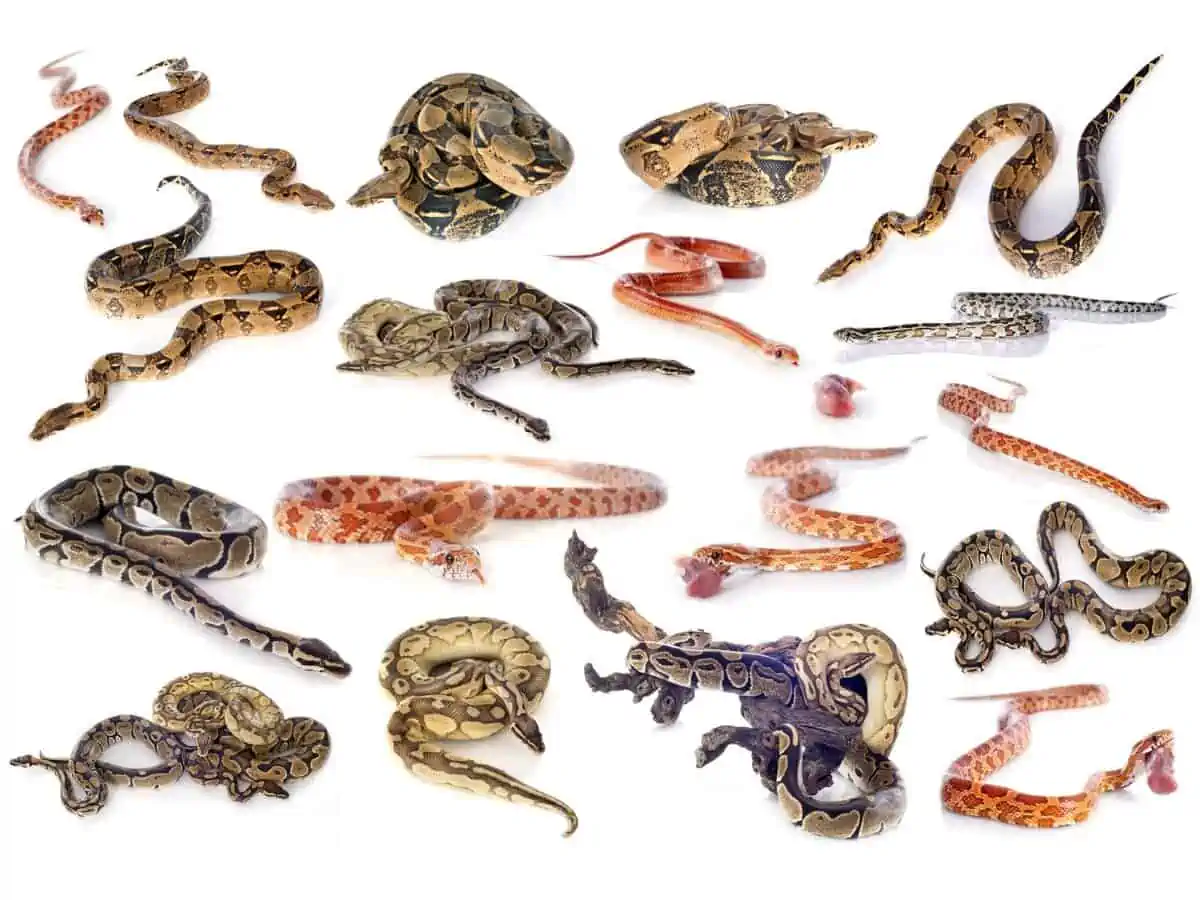
Different Texas Snakes With Yellow Bellies
There are over 105 species of snakes in Texas. However, only a handful have unique distinctions, such as yellow bellies. Although yellow-bellied snakes are uncommon, their population is enormous. For example, Plain-bellied Water Snakes are common in the swamps of Texas.
The following are the yellow belly snakes that you can find in the state:
- Yellow-bellied Kingsnake
- Garter Snake
- Eastern Yellow-bellied Racer
- Plain-bellied Water Snake
- Northern Ringneck Snake
These snakes differ in size, behavior, and habitat. One thing they have in common is that they’re not venomous. They only bite, but only at times when they need to defend themselves.
1. Yellow-bellied Kingsnake
Yellow-bellied Kingsnakes, also known as Prairie Kingsnakes, are commonly found in agricultural fields, suburban areas, and other open habitats. Additionally, they have green bodies with yellow bellies. Adult Yellow-bellied Kingsnakes can grow up to three feet long.
The Yellow-bellied Kingsnake, Lampropeltis calligaster, is a non-venomous snake in various parts of the United States, including Texas. Here are its physical characteristics and typical behaviors:
Physical Characteristics:
- Coloration and Markings: As its name suggests, the Yellow-bellied Kingsnake has a predominantly yellow or cream-colored underside. The top side is typically darker, ranging from olive to brown, often with darker blotches or stripes.
- Size: Adult Yellow-bellied Kingsnakes typically reach lengths of about 30 to 40 inches, although some can grow larger.
- Head: Like other kingsnakes, it has a slightly distinct head, which is not drastically set off from the neck, and round pupils.
- Body Shape: They have a moderately robust body, not as thick as some other constrictor species, but not slender like many colubrids.
Behavioral Characteristics:
- Diet: These snakes are constrictors and primarily feed on small mammals, birds, eggs, and other reptiles, including other snakes. They are known to be immune to the venom of pit vipers and will sometimes prey on venomous snakes.
- Habitat: Yellow-bellied Kingsnakes are often found in various habitats, including forests, grasslands, and near bodies of water. They are relatively versatile in their habitat preferences.
- Activity: They are primarily nocturnal but may be active during the day in cooler weather.
- Temperament: Like many kingsnakes, they are generally docile but can be defensive if threatened. They are known to vibrate their tails when agitated.
- Reproduction: Yellow-bellied Kingsnakes are oviparous, meaning they lay eggs. Mating occurs in the spring, and females lay eggs in early summer, which hatch in late summer or early fall.
- Hibernation: In colder climates, they may brumate (a form of hibernation) during the winter months.
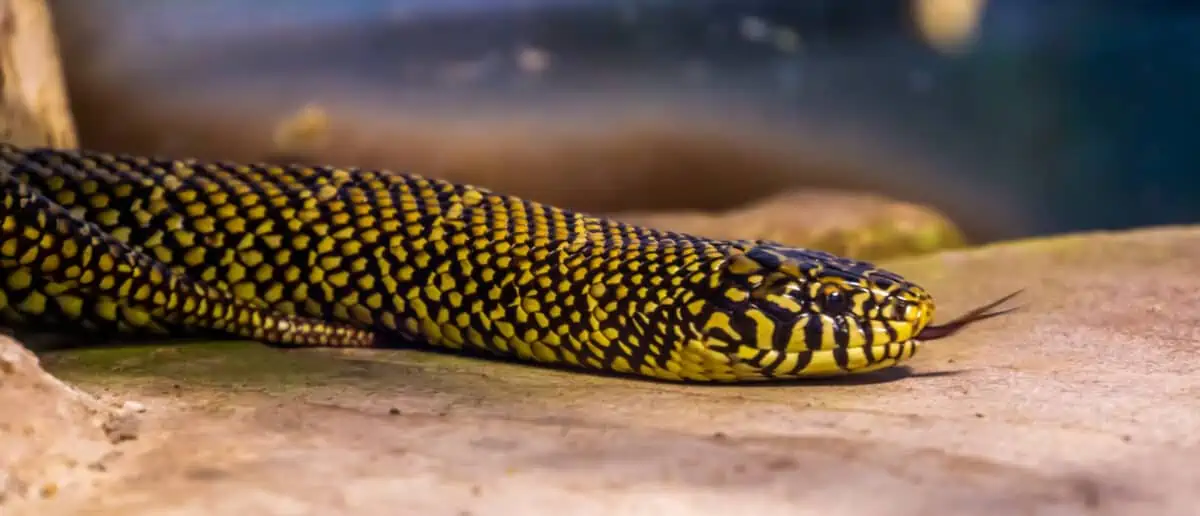
This species isn’t venomous, and they’re not aggressive either. Moreover, these snakes only feed on smaller snakes and reptiles. You can typically find them from April to November, although they’re very elusive, so they’re harder to come by.
2. Garter Snake
Garter Snakes are endemic to the United States. They usually reside near bodies of water or damp areas. Furthermore, their bodies have a green tinge with yellow stripes running down the middle of the back; they also have yellow bellies. Moreover, they grow up to two feet.
Garter snakes, the genus Thamnophis, are common, non-venomous snakes across North America. They exhibit various physical characteristics and behaviors, varying among the different species within this genus. Here’s an overview:
Physical Characteristics
- Size: Garter snakes are small to medium, typically 18 to 54 inches long, depending on the species.
- Coloration and Patterns: They are known for their distinct longitudinal stripes. Most have three stripes running the length of their bodies, one down the spine and one on each side. The coloration of these stripes can be yellow, green, blue, or white, contrasting with a darker body color, which can be black, brown, or green.
- Head: They have a slightly broader head than neck, but the distinction is not as pronounced as in some other snake species. Their eyes have round pupils.
- Body Shape: Garter snakes have slender, elongated bodies, and their scales have a slight keel (a raised ridge), giving them a somewhat rough texture.
Behavioral Characteristics
- Diet: Garter snakes are opportunistic eaters. Their diet primarily consists of amphibians, earthworms, leeches, slugs, and sometimes fish, small birds, or rodents. They use their sense of smell to track prey.
- Habitat: They are adaptable and can be found in various habitats, including meadows, woodlands, marshes, and near bodies of water. Garter snakes are often seen in urban and suburban areas.
- Activity Patterns: They are diurnal, being most active during the day, particularly in the morning and late afternoon.
- Temperament: Garter snakes are generally docile but can be defensive if threatened. When handled, they may release a musky scent from their anal glands as a defense mechanism.
- Reproduction: Garter snakes are ovoviviparous, giving birth to live young. Mating typically occurs in the spring, and females give birth to live young in late summer or early fall.
- Hibernation: In colder climates, garter snakes hibernate during the winter months. They often hibernate in large groups.
- Adaptability: They are one of the most adaptable snake species and are often one of the few to inhabit colder northern climates.
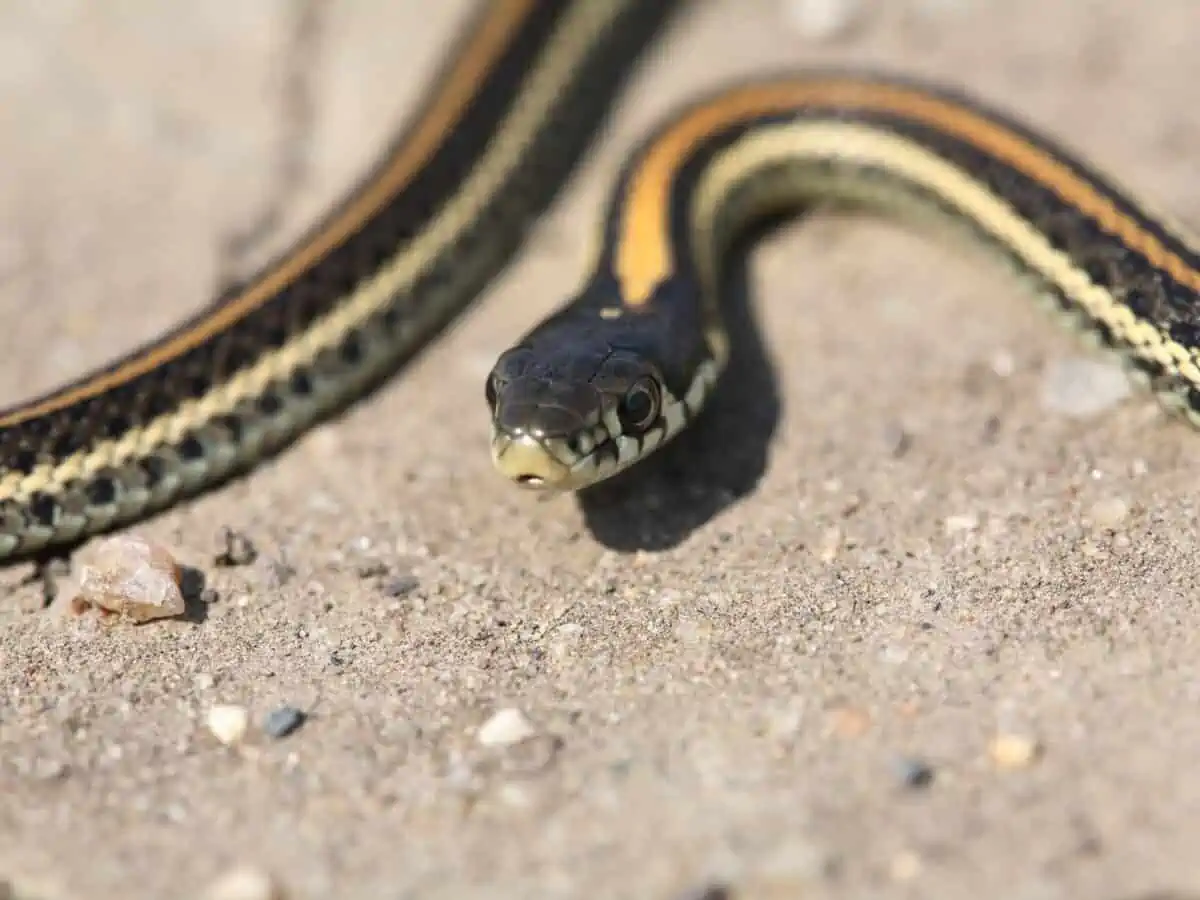
These snakes are harmless but tend to bite whenever they’re frightened. They aren’t venomous; their saliva only comes out when they bite. They enjoy burrowing in natural cavities and rock piles. In addition, they’re active from May to September because they hibernate during the winter season.
3. Eastern Yellow-bellied Racer
Eastern Yellow-bellied Racer is a thin snake whose length can reach up to five feet. These snakes have olive bodies with yellow bellies. In addition, they live in dry areas such as woods, pastures, and grasslands.
The Eastern Yellow-bellied Racer, Coluber constrictor flaviventris, is a subspecies of the non-venomous Coluber constrictor snake species commonly found in the United States. This particular subspecies exhibits distinct physical characteristics and behaviors.
Physical Characteristics:
- Coloration and Markings: As juveniles, Eastern Yellow-bellied Racers have a mottled pattern in gray, brown, or greenish, which fades as they mature. Adults typically have a uniform color on the dorsal side, ranging from olive to blue-gray or green, with a distinct yellow or cream-colored belly.
- Size: These snakes are relatively slender and can grow about 3 to 5 feet long.
- Head: They have a distinct head, slightly wider than the neck, with round pupils. The head might appear somewhat flattened.
- Body Shape: Their bodies are elongated and slender, with smooth scales that give them a glossy appearance.
Behavioral Characteristics:
- Diet: Eastern Yellow-bellied Racers primarily feed on insects, rodents, birds, eggs, reptiles, and amphibians. They are active hunters and are known for their speed and agility.
- Habitat: They prefer open and semi-open habitats, such as fields, prairies, lightly wooded areas, and edges of forests. They are also sometimes found in suburban areas.
- Activity: These snakes are diurnal, active primarily during the day. They are known for their quick movements, called “racer.”
- Temperament: Although non-venomous, they can be defensive if threatened and may vibrate their tails, strike, or bite. They are generally shy and will usually flee from danger.
- Reproduction: Eastern Yellow-bellied Racers are oviparous. The mating season is in the spring, and females lay eggs in early summer, which hatch in late summer or early fall.
- Hibernation: In colder regions, they hibernate during the winter, often in communal dens.
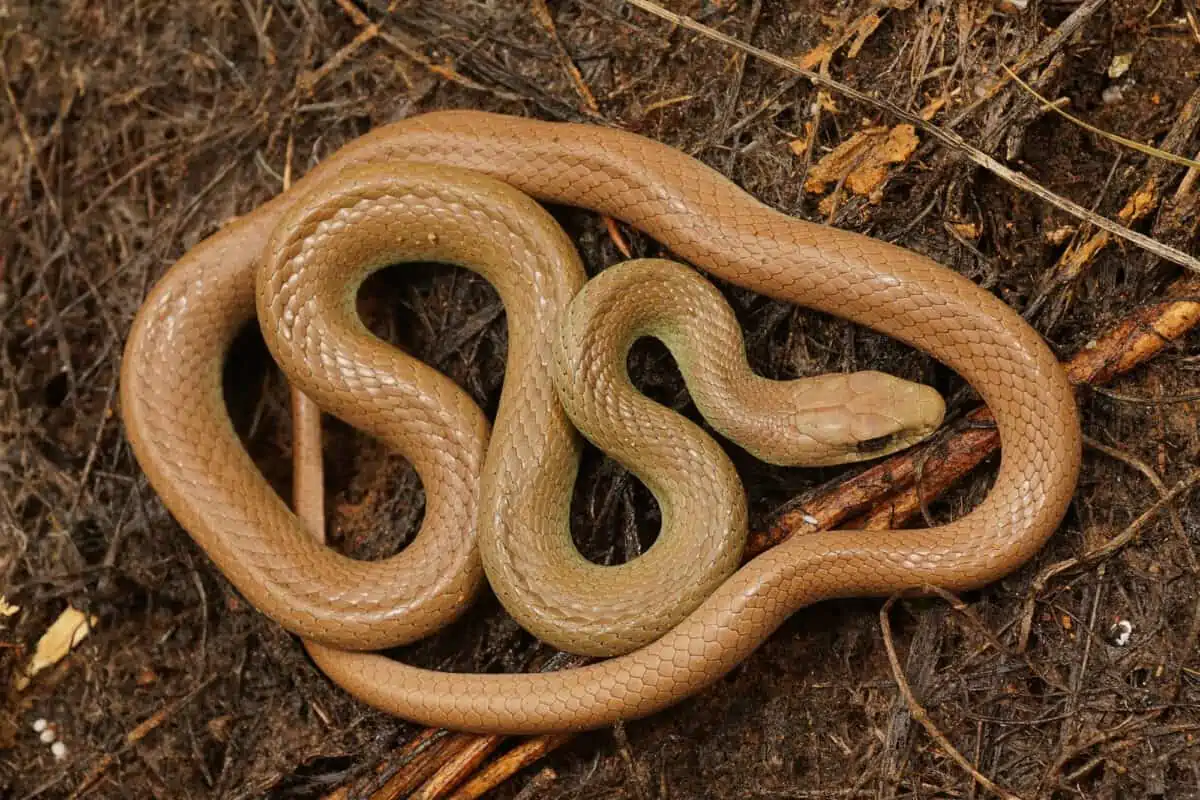
Racers move fast—they can easily catch up to their prey and can quickly hide when a predator pursues them. They’re aggressive when stressed, to the extent that they bite viciously. Eastern Yellow-bellied Racers are active during the daytime, and you can find them from March to November.
4. Plain-bellied Water Snake
From the name itself, Plain-bellied Water Snakes are aquatic snakes endemic to the United States. Their bodies are a solid color with yellow bellies. Even though they’re aquatic snakes, they also venture on land, hence why they reside in areas with a permanent water source, such as lakes, swamps, and rivers. Adult Plain-bellied Water Snakes grow up to three feet.
The Plain-bellied Water Snake, Nerodia erythrogaster, is a non-venomous species commonly found in the southeastern United States. They are a part of the Colubridae family and are known for their preference for aquatic habitats. Here are the key physical characteristics and typical behaviors of the Plain-bellied Water Snake:
Physical Characteristics
- Coloration and Markings: The Plain-bellied Water Snake has a solid, unmarked belly that is usually plain and can range from yellow to red. The dorsal side of the snake varies in color, commonly displaying shades of brown, gray, olive, or reddish-brown, often with darker, obscure crossbands.
- Size: Adult snakes of this species typically range from 24 to 40 inches in length. However, some individuals can grow larger.
- Head: The head is distinct and slightly broader than the neck. They have round pupils, consistent with non-venomous snake species.
- Body Shape: These snakes have a heavy, thick body, particularly in comparison to other water snakes. Their scales are keeled (ridged), which gives them a slightly rough texture.
Behavioral Characteristics
- Diet: They primarily feed on fish and amphibians. As opportunistic feeders, they may also consume other small aquatic creatures.
- Habitat: True to their name, Plain-bellied Water Snakes are found near various water sources such as rivers, lakes, marshes, and ponds. They are proficient swimmers.
- Activity Patterns: They are primarily diurnal, active during the day. However, in extremely hot weather, they may exhibit nocturnal behavior.
- Temperament: When threatened, they can be defensive and may hiss or bite. They are also known to release a foul-smelling musk from their cloacal glands as a defense mechanism.
- Reproduction: They are viviparous, giving birth to live young typically in late summer. The females do not lay eggs but rather carry the young until they are ready to be born.
- Hibernation: In colder climates, Plain-bellied Water Snakes hibernate during the winter, usually in rock crevices, burrows, or other sheltered spots.
- Interaction with Humans: While they are non-venomous, their defensive nature can be startling. It’s important to give them space and respect their habitat.
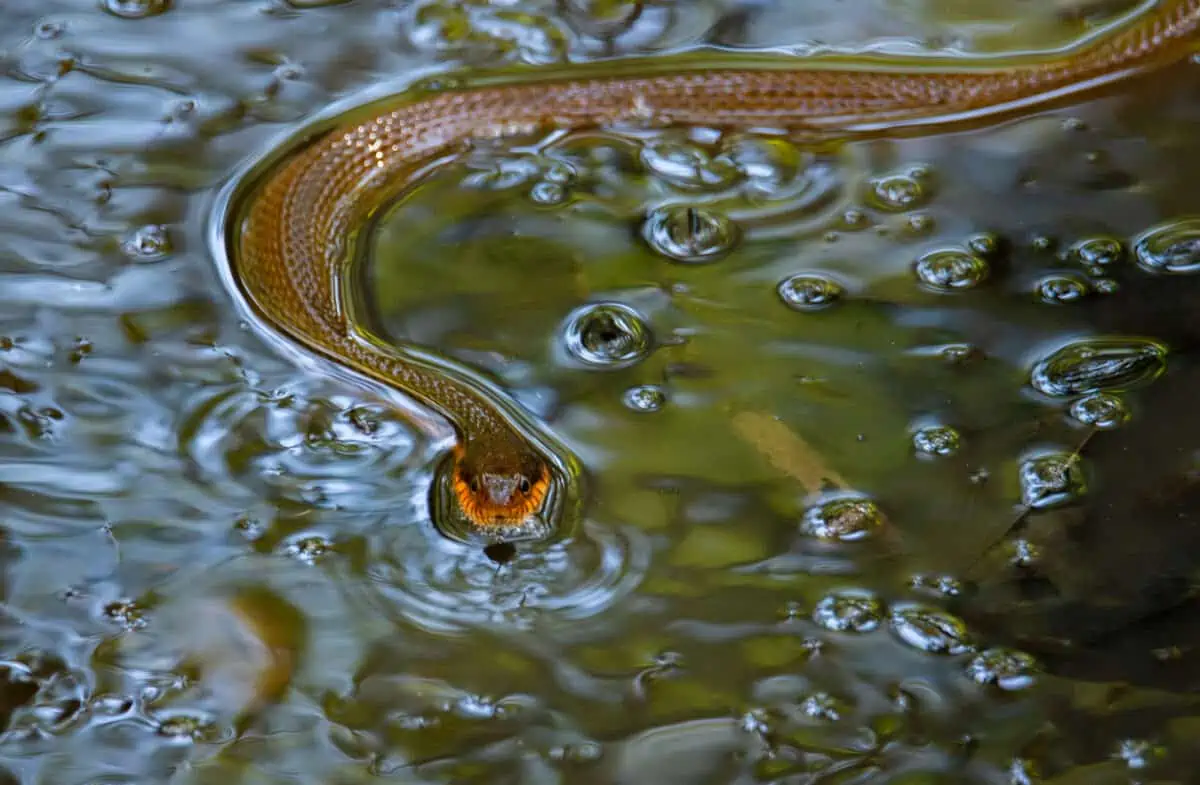
They’re most active during the summer, and you can find them swimming or traveling on land. Unlike other species, Plain-bellied Water Snakes feed on crayfish, frogs, and other amphibians they can find on the water. Furthermore, they’re not venomous but release a smelly odor as a defense mechanism.
5. Northern Ringneck Snake
Ring-necked Snakes are nocturnal snakes that grow up to two feet long. They have a solid-colored body, with a ring-like line interlaced into their neck. Moreover, these rings are frequently the same color as their bellies, which is yellow. They seek refuge in rocks, logs, and other moist areas.
The Northern Ringneck Snake, Diadophis punctatus edwardsii, is a small, non-venomous species of snake found widely in parts of North America. They are part of the Colubridae family, known for their distinctive neck ring and docile nature. Here are the physical characteristics and typical behaviors of the Northern Ringneck Snake:
Physical Characteristics
- Coloration and Markings: This snake is easily recognizable by the bright yellow or orange ring around its neck, contrasting with its dark gray, black, or bluish-black body. The belly is typically bright yellow or orange and may have black spots.
- Size: Northern Ringneck Snakes are relatively small, usually measuring between 10 and 15 inches in length. They have slender bodies.
- Head: The head is small and not distinctly set off from the neck. The eyes have round pupils, indicative of a non-venomous snake.
- Body Shape: They have smooth scales, giving them a glossy appearance and slender and delicate bodies.
Behavioral Characteristics
- Diet: Their diet primarily consists of small invertebrates, including earthworms, slugs, and insects. Occasionally, they may eat small amphibians and juvenile snakes of other species.
- Habitat: Northern Ringneck Snakes prefer moist, wooded areas, often found under rocks, logs, leaf litter, or other debris. They can also be found in grasslands, streams, or urban areas.
- Activity Patterns: They are primarily secretive and nocturnal, especially active during damp, rainy weather. During the day, they are typically hidden.
- Temperament: These snakes are known for their docile nature. When threatened, rather than biting, they are more likely to curl their tail, exposing the bright underside as a defensive display.
- Reproduction: Northern Ringneck Snakes are oviparous, laying eggs in moist, hidden locations. The eggs hatch in late summer or early fall.
- Interaction with Humans: They are harmless to humans and are often not seen due to their secretive and nocturnal habits.
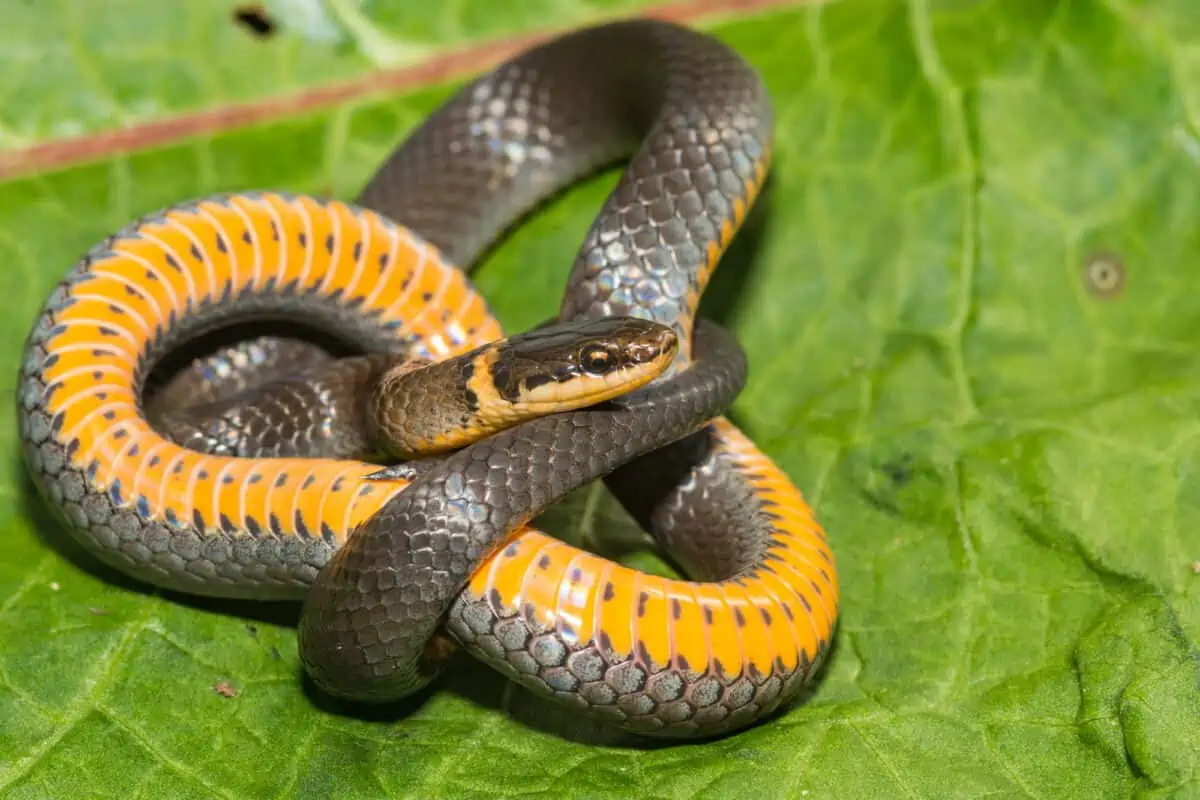
In addition, they have venom that they use in subduing their prey. However, it’s not potent enough to affect a human. They usually pursue reptiles, such as lizards, but they also eat insects.
Locations of Texas Snake with Yellow Belly
Generally, you can find snakes anywhere in Texas. However, finding yellow bellies is difficult because most of them are always burrowing, and they’re very secretive. But there are specific locations in Texas where they commonly live, which means the chances of sighting one are higher.
- Central Texas
- Southeast Texas
- Deep East Texas
Central Texas
Central Texas is the area that holds the largest number of snake species. As such, you can find yellow-bellied snakes here, particularly Ringneck Snakes, Eastern Yellow-bellied Racers, and Yellow-bellied Kingsnakes.
There’s an abundance of Ringneck Snakes near the Buchanan Dam. Moreover, there are sightings of Garter Snakes in Kempner. On the other hand, many people saw Eastern Yellow-bellied Racers throughout Austin. Most of the time, they’re hiding under rocks or the soil. It also depends on the season if they’ll travel or not.
Southeast Texas
South Texas is an excellent place where you can find a variety of snakes because there are more than 39 species in the area. You can also locate Eastern Yellow-bellied Racers in Southeast Texas.
People saw the snake in Houston, specifically at Lakewood Forest, Cypress Park, and the Addicks Reservoir. More Eastern Yellow-bellied Racers are scattered in the location, but the areas mentioned have plenty.
Deep East Texas
East Texas is an area that has a significant number of wetlands. As such, this is where Plain-Bellied Water Snakes reside. You’ll likely find the species in any wetland in the deeper part of East Texas.
The area has many rivers, creeks, and swamps, which are the perfect habitat for Plain-Bellied Water Snakes.
Yellow Bellies Snakes in Other Regions of the USA
| Species Name | Region Found | Key Characteristics |
|---|---|---|
| Yellow-bellied Kingsnake (Lampropeltis calligaster) | Central and Southern U.S. | Yellow or cream belly with speckles, slender body, up to 48 inches long. |
| Eastern Yellow-bellied Racer (Coluber constrictor flaviventris) | Central and Eastern U.S. | Uniform greenish, blue, or black back; yellow belly; up to 60 inches long. |
| Ring-necked Snake (Diadophis punctatus) | Throughout U.S. | Yellow or orange ring around neck; yellow or orange belly; up to 15 inches long. |
| Eastern Garter Snake (Thamnophis sirtalis) | Throughout U.S., especially in the East | Striped pattern; variable coloration; belly often pale yellow or cream. |
| Western Ribbon Snake (Thamnophis proximus) | Central and Western U.S. | Long, slender, with three bright stripes; yellowish belly; up to 40 inches long. |
| Plains Garter Snake (Thamnophis radix) | Central U.S. and Great Plains | Distinct stripes; often has a bright yellow belly; up to 28 inches long. |
| Common Kingsnake (Lampropeltis getula) | Southeastern U.S. | Variable coloration; some subspecies have yellowish bellies; up to 82 inches long. |
| Prairie Kingsnake (Lampropeltis calligaster calligaster) | Central U.S. | Grey or brown with dark blotches; yellow belly with dark spots; up to 40 inches long. |
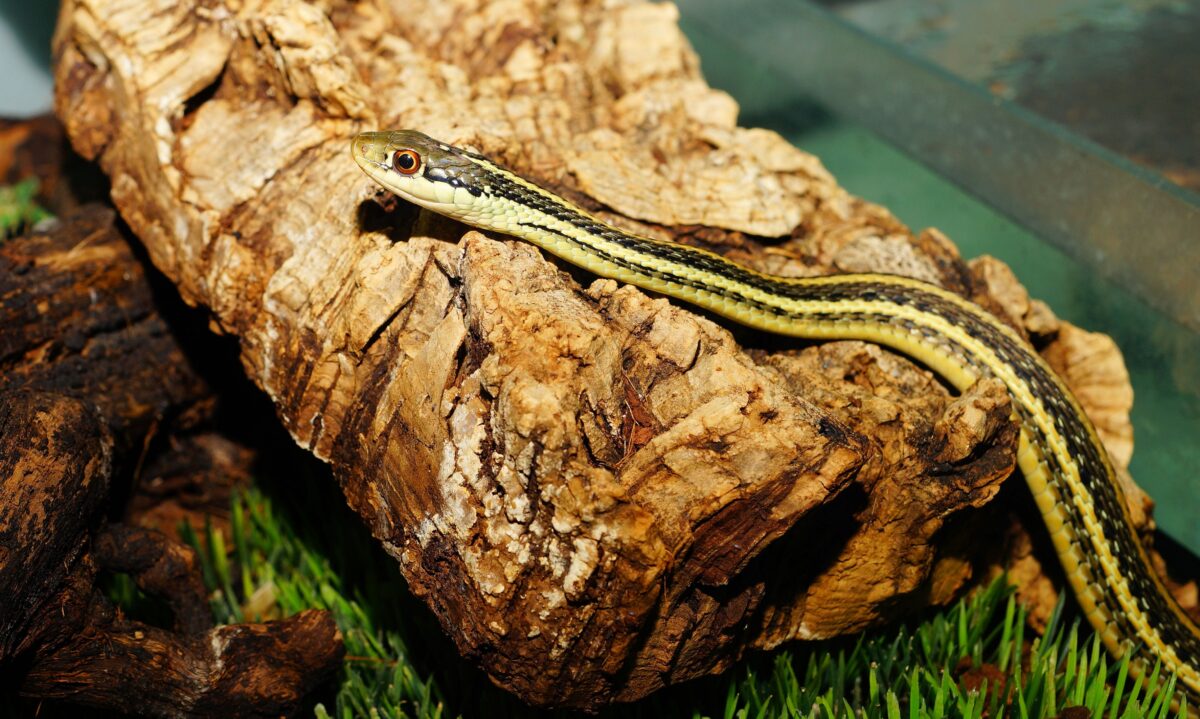
Safety Precautions if You Encounter a Snake with A Yellow Belly
Encountering a snake with a yellow belly, or any snake in general, can be a surprising and potentially unnerving experience, especially if you’re unsure whether the snake is venomous. Here are some safety precautions and steps to follow if you encounter such a snake:
Safety Precautions:
- Keep a Safe Distance: Maintain a minimum distance of several feet. Snakes usually strike only when they feel threatened or cornered.
- Do Not Attempt to Handle: Never pick up or touch the snake. Many bites occur when people try to handle or kill snakes.
- Stay Calm: Move away slowly and calmly without sudden movements to avoid alarming the snake.
- Identify from Afar: If you want to identify the snake, do so from a distance. Use binoculars or zoom in with a camera.
- Keep Pets Away: If you have a pet with you, keep them on a leash and away from the snake.
- Avoid Bushes and Tall Grass: When in snake territory, stay on clear paths. Snakes can be hidden in undergrowth.
- Wear Protective Clothing: If you’re in an area known for snakes, wear long pants, boots, and gloves for added protection.
If You Encounter a Snake:
- Stop and Assess: Freeze and assess the situation. Determine the snake’s location and whether it has noticed you.
- Slowly Back Away: Slowly and calmly move away from the snake. Give it plenty of room to escape.
- Do Not Corner the Snake: Ensure the snake has an escape route. Snakes are more likely to strike if they feel trapped.
- Observe Behavior: If the snake is hissing, coiling, or raising its head, it’s a sign of feeling threatened. Increase your distance.
If Bitten:
- Seek Medical Attention Immediately: Even if you believe the snake is non-venomous, get medical help. Infections and allergic reactions can occur.
- Remain Calm and Immobilize the Area: Keep the bitten area still and below heart level to slow the spread of venom (if any).
- Remove Constrictive Clothing or Jewelry: Swelling can occur, so remove anything that could constrict near the bite site.
- Do Not Cut or Suck the Wound: This can increase the risk of infection and does not effectively remove venom.
- Do Not Apply Ice or a Tourniquet: These methods can cause more harm than good.
- Remember the Snake’s Appearance: If possible, take note of the snake’s size, color, and shape for identification purposes. This can assist medical personnel.
Prevention:
- Educate Yourself and Others: Learn about the local snake species in your area. Educating children on how to react to a snake sighting is also crucial for safety.
- Keep Your Yard Clean: Reduce debris, tall grass, and rock piles where snakes may hide.
- Use Caution in Snake Habitats: Be extra cautious in areas known for snake activity, especially during warmer months when they are more active.
Remember, most snakes are not aggressive and will not attack unless provoked or threatened. Respecting their space and taking precautions can prevent most negative encounters.
Yellow Snakes FAQs
Can I see snakes with yellow bellies only in Texas?
The species mentioned aren’t native to Texas. The snakes come from different areas, but they’ve reached the state because they travel a lot. Even though there are a bunch of Plain-Bellied Water Snakes in East Texas, you can still find them in other locations, such as Florida.
Is there a reason a Texas snake with a yellow belly has such color?
The only reason why the snakes have yellow bellies is that it’s in their genes. There’s a high chance that it resulted from a random mutation from other snakes.
References:
- Over 105 species of snakes in Texas: tbpwd.texas.gov
- East Texas: twri.tamu.edu
Christian Linden is a seasoned writer and contributor at Texas View, specializing in topics that resonate with the Texan community. With over a decade of experience in journalism, Christian brings a wealth of knowledge in local politics, culture, and lifestyle. He holds a Bachelor's degree in Communications from the University of Texas. When he's not writing, Christian enjoys spending weekends traveling across Texas with his family, exploring everything from bustling cities to serene landscapes.











